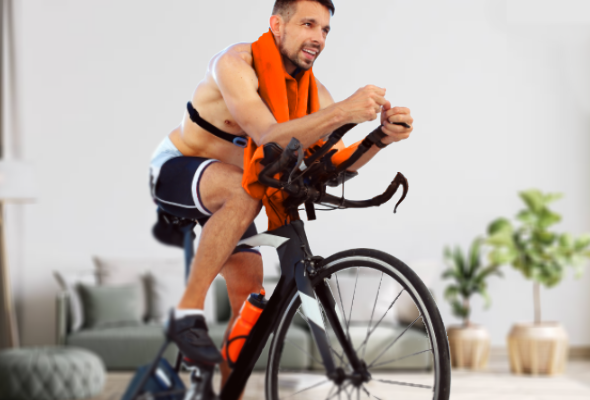
The autumn and winter season is a real curse for cyclists. Because while you can dress appropriately for low temperatures, driving on a wet or frozen surface is simply dangerous. Most athletes switch to an indoor trainer at this time, spinning safely at home. One can be rescued from the monotony by taking part in virtual races using programs such as Zwift. Thanks to appropriate nutrition strategies, matched to the length and intensity of the activity, you can significantly improve training results and perhaps even triumph in a virtual race.
How to eat while training at home?
Essentially, the nutritional recommendations for home workouts are no different than those for outdoor cycling. What’s more, home conditions offer you more opportunities to experiment with various gels, fruits, bars or drinks. Prepared foods can be safely placed on the table next to the bike, without worrying if everything we planned will fit in the pockets of the cycling jersey. It is worth, however, as in the case of outdoor training, to portion out your snacks beforehand. This will help you determine your carbohydrate intake in each hour of riding and will also be a big help during intense Zwift racing.
The basics of nutrition
Short workouts – not even exceeding an hour, do not require any complicated nutritional strategy apart from a few practical rules:
For long hours of effort, such as a typical summer ride, it is recommended to consume 60 to even 90 g of carbohydrates every hour of cycling. Although the recommended values may seem high and at the beginning of the adventure with nutrition during exercise, difficult to implement, it is worth mentioning that professional cyclists such as Chris Froome or Mathieu van der Poel can consume up to 100-120 g of carbohydrates every hour of participation in a race, achieving phenomenal results.
If you want to get even closer to the amount of food consumed by professional athletes, you should carry out “gut training” – consisting of: successively increasing the amount of food consumed during training reflecting the race, training after a large meal, consuming various carbohydrate mixes, including those containing fructose.
If you start your adventure with nutrition during exercise, these are the rules to stick to:
To summarise – the period of home training, including intensive sessions on Zwift, can be effectively used both in terms of training adaptations and the development of nutritional strategies. Nutritional recommendations do not differ significantly from those concerning outdoor training and recommend the consumption of 60-90 g of carbohydrates per hour of riding, in the case of long-hour training. Particularly noteworthy is the “gut-training”, consisting of increasing food intake during intense exercise. This causes adaptation and tolerance for a given product, which can be an undoubted advantage/benefit when the outdoor riding season arrives.

daily workout and nutritional advice
to maximise performance
exclusive discounts and offers
Be the first to hear about new products
Fitness Authority® Sp. z o.o.
Konna 40, Otomin – Poland
NIP: 957 103 70 01
KRS: 0000355208
P: +48 58 522-07-56
E-mail: contact@vitarade.com